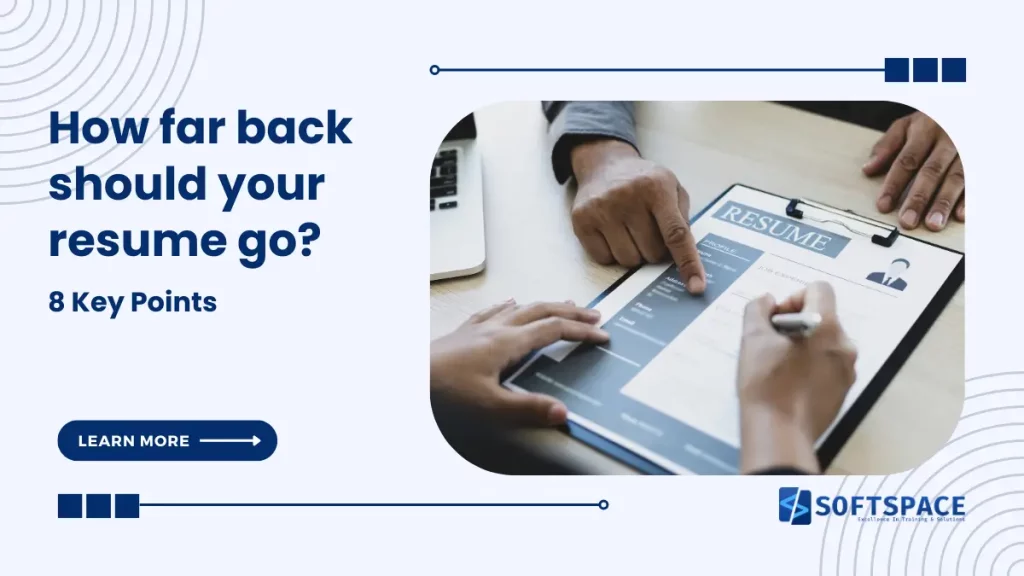In today’s competitive job market, crafting a standout resume is essential. But when it comes to the length of your work history, how far back should your resume go? This is a common question that many job seekers grapple with. While there is no hard and fast rule, it’s important to strike the right balance between showcasing your experience and keeping your resume concise.
One school of thought suggests that your resume should only include the past 10-15 years of work experience. This approach allows you to focus on your most recent and relevant accomplishments while avoiding unnecessary clutter. However, there may be instances where including older experience can be beneficial, especially if it highlights valuable skill development and demonstrates career progression.
Ultimately, the decision on how far back to go on your resume depends on several factors, such as the relevance of past roles, the industry you’re in, and the specific job you’re applying for. It’s important to consider each situation individually and tailor your resume accordingly.
In this article, we’ll explore different perspectives on this topic and provide practical tips to help you make an informed decision on how far back should your resume go.
Table of Contents
How far back should your resume go?
Your resume should mostly show your recent work experience, like the past 10-15 years. This way, it’s easier for hiring managers to quickly see your most relevant skills for the job. Here’s how far back should your resume go:
- Focus: Bosses look at resumes quickly, so you want yours to be short and show your best skills. Older jobs might make it harder for them to find what they need.
- Up-to-date skills: The things you learned at work can get old over time. Employers might care more about what you learned recently.
- Less age focus: Including older jobs might show your age, and that’s not something you can control! By focusing on recent experience, you keep the spotlight on your skills.
There are a few exceptions:
- New to work or changing careers? Show all your relevant experience, even if it’s older than 10-15 years.
- Gaps in your work history? Older jobs might help explain them.
- The job listing asks for it. Some jobs, like teaching or research, might want to see your entire work history.
Here’s a quick guide:
- New to work: Show all relevant experience.
- Mid-career (10-15 years experience): Show the past 10-15 years.
- Experienced (more than 15 years): Show the past 10-15 years, but you can also mention relevant skills or achievements from older jobs in a separate section.
Key Points to be mentioned in the resume
Here are the key points to mention in your resume:
- Contact Information: Make it easy for employers to reach you by including your full name, phone number, professional email address, and LinkedIn profile (optional) at the top of your resume.
- Summary or Objective (Optional): A brief overview (2-3 sentences) of your skills, experience, and career goals can be a great way to grab the reader’s attention. Tailor this section to the specific job you’re applying for.
- Work Experience: This is the heart of your resume. List your work experience in reverse chronological order (most recent first). For each position, include:
- Job Title & Company Name
- Dates of Employment
- 2-3 bullet points highlighting your key responsibilities, achievements, and skills used. Focus on quantifiable results whenever possible (e.g., “Increased sales by 20%”).
- Skills: Showcase your skills in a dedicated section. Include both hard skills (technical abilities) and soft skills (interpersonal qualities). Use keywords from the job description to highlight relevant skills.
- Education: List your educational background, including:
- Degree Name & Major
- University/College Name & Location
- Graduation Year (optional)
- Relevant coursework or projects (optional)
- Certifications & Awards (Optional): List any relevant professional certifications or awards you’ve earned.
- Additional Sections (Optional): Consider including additional sections to showcase your well-roundedness, such as volunteer experience, foreign languages spoken, or relevant projects.
Remember:
- Keep it concise: Aim for a one-page resume for most positions.
- Proofread carefully: Typos and grammatical errors can hurt your chances.
- Tailor it to the job: Highlight skills and experience most relevant to the specific position.
- Use strong action verbs: Emphasize your accomplishments and contributions.
The One-Page Resume Myth: Debunking the Traditional Rule
The idea of fitting your entire work history on a single page has long been a popular belief in the resume world. However, this “one-page resume rule” is not as strict as it once was. While a concise and focused resume is generally preferred, it’s more important to include relevant information rather than adhere to an arbitrary page limit.
Recruiters and hiring managers understand that professionals with extensive experience may require more space to showcase their qualifications. Instead of obsessing overfitting everything onto one page, prioritize the quality and impact of the content you include. If you have relevant achievements and skills from early in your career that can strengthen your application, it’s worth considering including them.
Factors to Consider When Deciding How Far Back Your Resume Should Go
Think of your resume as a commercial for your skills and experience. Just like a commercial, you want it to be clear, catchy, and focused on the right product (you!) for the job. So, how far back should you go in your work history? Here’s what to consider:
- Keep it Recent: Hiring managers typically focus on the past 10-15 years of experience. This ensures your skills are relevant and up-to-date for the job you’re applying for.
- Focus on Relevance: The earlier your experience, the less relevant it might be to your current career goals. Highlight jobs that showcase skills and achievements directly related to the position you want.
- Early Career or Career Change? If you’re new to the workforce or switching careers, include all relevant experience, even if it’s older than 10-15 years.
- Gaps in Employment? Older jobs can help explain gaps in your work history. Briefly mention them and highlight what you learned or accomplished during that time.
- Job Description Matters: Some jobs, especially in research or academia, might ask for your entire work history. Always tailor your resume to the specific requirements of the position.
Recent Experience: Highlighting Your Most Relevant Roles
The most recent 10-15 years of your work history are typically the most relevant to potential employers. This is especially true if your roles during this period align closely with the position you’re applying for. Hiring managers are interested in seeing your recent accomplishments and how they relate to the skills and responsibilities required in the job description.
When listing your recent experience, focus on highlighting your most significant achievements and responsibilities. Use action verbs and quantify your accomplishments wherever possible to make them more impactful. By showcasing your recent experience effectively, you can capture the attention of recruiters and demonstrate your ability to excel in the role.
Mid-Career Experience: Balancing Relevance and Depth
For professionals with a mid-career level of experience, striking a balance between relevance and depth is key. While it’s important to include your recent roles and achievements, it can also be beneficial to provide some insight into earlier positions that demonstrate career progression or relevant skills.
Consider including a condensed version of your mid-career experience, focusing on the roles that are most relevant to your current career goals. Highlight the skills and accomplishments that are transferable to the job you’re applying for. This will help showcase your growth and expertise over time, while still keeping your resume concise.
3. Early Career Experience: Including Relevant Achievements and Skills
Including early career experience on your resume can be advantageous, especially if it showcases relevant achievements and skills. While roles from the early stages of your career may not be as recent, they can demonstrate your foundation and expertise in a particular field.
When listing early career experience, focus on the accomplishments and skills that are most relevant to the job you’re applying for. If you have limited space on your resume, consider condensing this section or combining multiple roles under a single heading. The goal is to provide enough information to demonstrate your competence and potential, without overwhelming the reader with unnecessary details.
Tailoring How Far Back Should Your Resume Go
One of the most important aspects of creating an effective resume is tailoring it to each job application. This includes deciding how far back to go with your work history based on the specific job you’re applying for. Here are some tips to help you customize your resume for each application:
- Review the job description: Carefully read the job description and identify the key skills and qualifications required. Focus on highlighting your relevant experience and accomplishments that align with these requirements.
- Prioritize recent roles: If your recent roles closely match the job requirements, emphasize them on your resume. Include specific achievements and responsibilities that demonstrate your ability to excel in the position.
- Consider the industry norms: Different industries may have varying expectations when it comes to resume length and the inclusion of past experience. Research industry norms and adjust your resume accordingly.
- Remove outdated or irrelevant information: If you have experience that is no longer applicable or outdated, consider removing it from your resume. This will help keep your resume focused and ensure that you’re highlighting your most relevant qualifications.
Remember, each job application is unique, and tailoring your resume accordingly can significantly increase your chances of landing an interview.
Formatting Tips for Managing Resume Length
Resumes should be clear, and concise, and highlight your best qualifications. But how do you squeeze everything in without going overboard on pages? Here are some formatting tricks to keep your resume on a single, powerful page:
- Font & Size: Ditch the fancy fonts! Stick to professional, easy-to-read options like Arial or Times New Roman. Use a font size between 10 and 12 points for readability.
- Margins: Standard margins are 1 inch on all sides. You can squeeze to 0.5 inches if needed, but be careful not to cramp the text.
- Sections & Headings: Divide your resume into clear sections like “Experience,” “Skills,” and “Education.” Use bold headings to make it easy for scanners to find the information they need.
- Bullet Points: Bullet points are your friend! They save space and make your achievements easily digestible. Keep them concise and action-oriented.
- Whittle Words: Every word counts! Use strong verbs and impactful language to describe your skills and accomplishments. Don’t repeat information – focus on the most relevant details for the job.
- Tailor It: Don’t use a one-size-fits-all resume! Highlight skills and experiences most relevant to the specific job you’re applying for.
By following these tips, you can create a resume that’s impactful and keeps your most valuable experience on display, all within a single page.
The Impact of Technology: How ATS Affects Resume Length
In today’s digital age, many companies use Applicant Tracking Systems (ATS) to streamline the hiring process. These systems scan resumes for keywords and specific qualifications, helping employers filter through a large number of applications. The use of ATS has implications for resume length.
When crafting your resume, it’s important to consider the ATS algorithms that may be used by potential employers. These systems often prioritize recent roles and keywords related to the job description. As a result, including older experiences that may not be as relevant could decrease your chances of passing the initial screening process.
To optimize your resume for ATS, focus on including keywords and key skills that are relevant to the job you’re applying for. Tailor your resume to match the specific requirements outlined in the job description. By doing so, you increase your chances of making it through the initial screening process and getting your qualifications noticed by human recruiters.
To Conclude: How far back should your resume go?
In conclusion, determining how far back your resume should go is not a one-size-fits-all approach. It depends on various factors, including the relevance of past roles, the industry you’re in, and the specific job you’re applying for. While it’s generally advisable to focus on your most recent and relevant experience, there may be instances where including older roles can be beneficial.
When crafting your resume, remember to tailor it to each job application, highlighting your most relevant qualifications and achievements. Use concise language, be selective with the details you include, and consider the impact of ATS on resume length. By striking the right balance between showcasing your experience and keeping your resume concise, you can increase your chances of standing out in today’s competitive job market.

13+ Yrs Experienced Career Counsellor & Skill Development Trainer | Educator | Digital & Content Strategist. Helping freshers and graduates make sound career choices through practical consultation. Guest faculty and Digital Marketing trainer working on building a skill development brand in Softspace Solutions. A passionate writer in core technical topics related to career growth.




